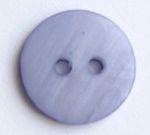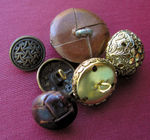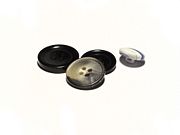Button
2008/9 Schools Wikipedia Selection. Related subjects: Engineering
In clothing and fashion design, a button is a small plastic or metal disc- or knob-shaped, typically round, object usually attached to an article of clothing in order to secure an opening, or for ornamentation. Functional buttons work by slipping the button through a fabric or thread loop, or by sliding the button through a reinforced slit called a buttonhole.
Buttons may be manufactured from an extremely wide range of materials, including natural materials such as antler, bone, horn, ivory, shell, vegetable ivory, and wood; or synthetics such as celluloid, glass, metal, bakelite and plastic.
Hard plastic is by far the most common material for newly manufactured buttons; the other materials tend to occur only in premium apparel.
History
Buttons and button-like objects used as ornaments rather than fasteners have been discovered in the ancient Indus Valley during its Kot Dijy phase (circa 2800- 2600 BC) and Bronze Age sites in China (circa 2000- 1500 BC), and are attested in Ancient Rome.
Functional buttons with buttonholes for fastening or closing clothing appeared first in Germany in the 13th century. They soon became widespread with the rise of snug-fitting garments in 13th- and 14th-century Europe.
Types of buttons
- Shank buttons have a small ring or a bar with a hole called the shank protruding from the back of the button, through which thread is sewn to attach the button.
- Covered buttons are fabric-covered forms with a separate back piece that secures the fabric over the knob.
- Flat or sew-through buttons have two or four holes punched through the button through which the thread is sewn to attach the button. Flat buttons may be attached by sewing machine rather than by hand, and may be used with heavy fabrics by working a thread shank to extend the height of the button above the fabric.
- Worked or cloth buttons are created by embroidering or crocheting tight stitches (usually with linen thread) over a knob or ring called a form.
- Mandarin buttons or Frogs are knobs made of intricately knotted strings. Mandarin buttons are a key element in Mandarin dress ( Qi Pao and cheongsam in Chinese), where they are closed with loops. Pairs of mandarin buttons worn as cuff links are called silk knots.
Button sizes
The size of the button depends on its use. Shirt buttons are generally small, and spaced close together, whereas coat buttons are larger and spaced further apart. Buttons are commonly measured in lignes (also called lines and abbreviated L), with 40 lignes equal to 1 inch. For example, some standard sizes of buttons are 16 lignes (10.16 mm, standard button of men's shirts) and 32 lignes (20.32 mm, typical button on suit jackets).
Buttonholes
Functional buttons (as opposed to decorative buttons) are normally paired with a buttonhole. Alternately, a decorative loop of cloth or rope may replace the buttonhole. Buttonholes may be either made by hand sewing or automated by a sewing machine.
Buttonholes often have a bar at either end. This is a row of perpendicular hand or machine stitching to reinforce the ends of a buttonhole.



